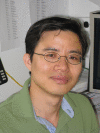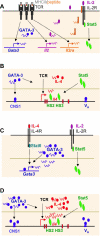CD4 T cells: fates, functions, and faults
- PMID: 18725574
- PMCID: PMC2518872
- DOI: 10.1182/blood-2008-05-078154
CD4 T cells: fates, functions, and faults
Abstract
In 1986, Mosmann and Coffman identified 2 subsets of activated CD4 T cells, Th1 and Th2 cells, which differed from each other in their pattern of cytokine production and their functions. Our understanding of the importance of the distinct differentiated forms of CD4 T cells and of the mechanisms through which they achieve their differentiated state has greatly expanded over the past 2 decades. Today at least 4 distinct CD4 T-cell subsets have been shown to exist, Th1, Th2, Th17, and iTreg cells. Here we summarize much of what is known about the 4 subsets, including the history of their discovery, their unique cytokine products and related functions, their distinctive expression of cell surface receptors and their characteristic transcription factors, the regulation of their fate determination, and the consequences of their abnormal activation.
Figures







Similar articles
-
In Vitro Differentiation of Effector CD4+ T Helper Cell Subsets.Methods Mol Biol. 2019;1960:75-84. doi: 10.1007/978-1-4939-9167-9_6. Methods Mol Biol. 2019. PMID: 30798522
-
Modulation of chemokine receptor expression and chemotactic responsiveness during differentiation of human naive T cells into Th1 or Th2 cells.Eur J Immunol. 2002 May;32(5):1264-73. doi: 10.1002/1521-4141(200205)32:5<1264::AID-IMMU1264>3.0.CO;2-S. Eur J Immunol. 2002. PMID: 11981813
-
C-C chemokine receptor 4 expression defines a major subset of circulating nonintestinal memory T cells of both Th1 and Th2 potential.J Immunol. 2001 Jan 1;166(1):103-11. doi: 10.4049/jimmunol.166.1.103. J Immunol. 2001. PMID: 11123282
-
CD4⁺T cells: differentiation and functions.Clin Dev Immunol. 2012;2012:925135. doi: 10.1155/2012/925135. Epub 2012 Mar 14. Clin Dev Immunol. 2012. PMID: 22474485 Free PMC article. Review.
-
Specifying helper T cell fates during immunity.J Pediatr Gastroenterol Nutr. 2008 Apr;46 Suppl 1:E19-20. doi: 10.1097/01.mpg.0000313832.47207.0e. J Pediatr Gastroenterol Nutr. 2008. PMID: 18354322 Review. No abstract available.
Cited by
-
Decoding mutational hotspots in human disease through the gene modules governing thymic regulatory T cells.Front Immunol. 2024 Oct 15;15:1458581. doi: 10.3389/fimmu.2024.1458581. eCollection 2024. Front Immunol. 2024. PMID: 39483472 Free PMC article.
-
HIF1α-regulated glycolysis promotes activation-induced cell death and IFN-γ induction in hypoxic T cells.Nat Commun. 2024 Oct 30;15(1):9394. doi: 10.1038/s41467-024-53593-8. Nat Commun. 2024. PMID: 39477954 Free PMC article.
-
Mannose and Lactobionic Acid in Nasal Vaccination: Enhancing Antigen Delivery via C-Type Lectin Receptors.Pharmaceutics. 2024 Oct 8;16(10):1308. doi: 10.3390/pharmaceutics16101308. Pharmaceutics. 2024. PMID: 39458637 Free PMC article. Review.
-
Immunomodulatory Effects of a Prebiotic Formula with 2'-Fucosyllactose and Galacto- and Fructo-Oligosaccharides on Cyclophosphamide (CTX)-Induced Immunosuppressed BALB/c Mice via the Gut-Immune Axis.Nutrients. 2024 Oct 19;16(20):3552. doi: 10.3390/nu16203552. Nutrients. 2024. PMID: 39458546 Free PMC article.
-
TH1 Cell Frequency and Neutrophil-to-Lymphocyte Ratio in Hemodialysis: Potential Contributions to Patient Monitoring.Biomedicines. 2024 Sep 26;12(10):2188. doi: 10.3390/biomedicines12102188. Biomedicines. 2024. PMID: 39457501 Free PMC article.
References
-
- Mosmann TR, Cherwinski H, Bond MW, Giedlin MA, Coffman RL. Two types of murine helper T cell clone. I. Definition according to profiles of lymphokine activities and secreted proteins. J Immunol. 1986;136:2348–2357. - PubMed
-
- Sakaguchi S. Naturally arising CD4+ regulatory T cells for immunologic self-tolerance and negative control of immune responses. Annu Rev Immunol. 2004;22:531–562. - PubMed
-
- Shevach EM. From vanilla to 28 flavors: multiple varieties of T regulatory cells. Immunity. 2006;25:195–201. - PubMed
-
- Bendelac A, Savage PB, Teyton L. The biology of NKT cells. Annu Rev Immunol. 2007;25:297–336. - PubMed
-
- Mosmann TR, Coffman RL. TH1 and TH2 cells: different patterns of lymphokine secretion lead to different functional properties. Annu Rev Immunol. 1989;7:145–173. - PubMed
Publication types
MeSH terms
Substances
Grants and funding
LinkOut - more resources
Full Text Sources
Other Literature Sources
Research Materials
Miscellaneous


